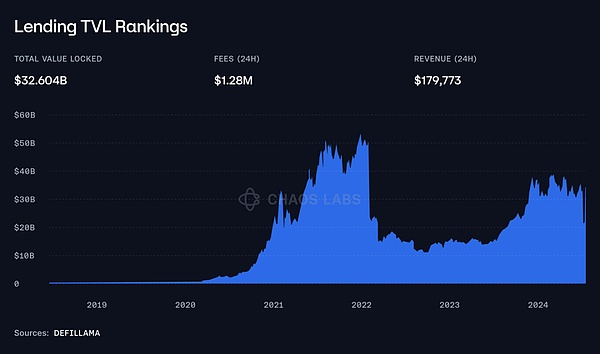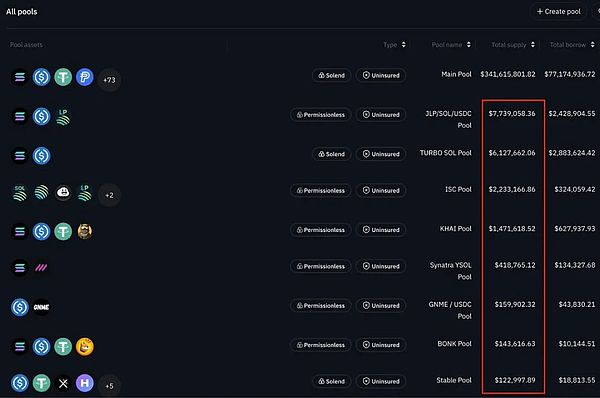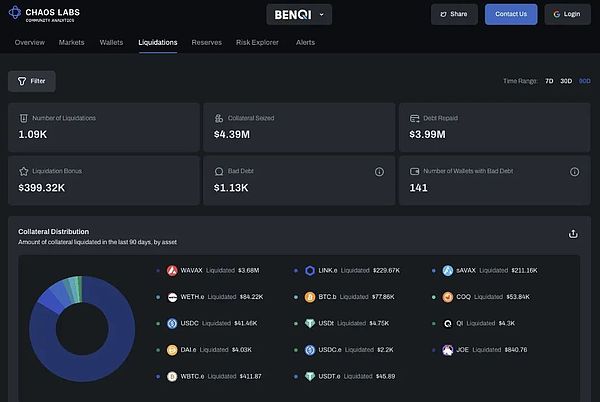In traditional finance, lending markets offer short-term borrowing opportunities, typically for liquid and low-risk assets, with the goal of providing a safe and highest possible yield. In decentralized finance (DeFi), the concept has evolved to refer primarily to the ability to borrow and lend a variety of digital assets in a decentralized and permissionless environment, with no specific time limits. These platforms allow users to deposit cryptocurrencies into the protocol, and borrowers pay interest to depositors in exchange for providing sufficient collateral.
Lending markets usedynamic interest rate modelsto automatically adjust borrowing rates based on the liquidity utilization of a certain market or pool. These models ensure efficient allocation of capital while incentivizing borrowers to return borrowed assets when liquidity is tight.
A key feature of this interest rate model is the “kink point”, which is when the utilization rate reaches a certain critical value and the interest rate begins to rise significantly to control the leverage in the system: as the utilization rate rises, the interest rate may increase gradually, but once it exceeds the inflection point, the interest rate will soar rapidly, causing a significant increase in borrowing costs.
It should be noted that the lending market is different from unsecured loans: the lending market requires borrowers to provide collateral to guarantee the loan to ensure that it can be repaid at any time within the loan period; while unsecured loans (usually referring to traditional loans) allow customers to borrow without providing collateral (or only providing partial collateral or other guarantees), and the repayment of the loan depends on credit scores and legal means to guarantee.
Lending Market: The Basic "Lego" in the DeFi Ecosystem
The importance of the lending market in DeFi is mainly reflected in its ability to help users earn income and unlock liquidity through idle assets without selling their holdings. This feature plays a vital role in DeFi capital efficiency. The ability to borrow based on a specific token is one of the most sought-after features in the industry and is often an important criterion for determining whether a crypto asset is a "blue chip" asset.
This feature enables users to obtain leverage at a low cost, helping high net worth individuals (HNWIs) include assets in tax planning, and also enables teams with abundant assets but insufficient liquidity to support operating funds by borrowing against treasury and held assets, and earn interest on the collateral in the process (for example, Curve and Maker in the past few years are two typical cases).
In addition, the lending market also serves as the backbone of other DeFi tools, such as collateralized debt positions (CDPs), yield farming strategies (supporting many nearly "delta neutral" strategies), and on-chain margin trading. Therefore, the lending market is one of the most important building blocks of DeFi, also known as the "building blocks of funds."
To give you a clearer understanding of the scale of these lending markets, the total locked value (TVL) in crypto lending protocols has now exceeded $32.6 billion, as shown in the figure below.

Source: Defillama
Design Decisions in Crypto Lending Markets: Shared vs. Segregated Liquidity Pools
While cryptocurrency lending markets all serve the same basic purpose, there are significant differences in the design of their liquidity structures. The biggest distinction is between markets that use a single shared liquidity pool (like @Aave) and those that employ segregated liquidity pools (like Compound v3). Each model has its own tradeoffs, influencing factors such as liquidity depth, asset flexibility, and risk management. Segregated Liquidity Pools: Flexibility vs. Risk Isolation In the segregated liquidity pool model, each market or asset operates within its own separate liquidity pool. This approach is used by protocols like Compound v3 and, in even more extreme cases, platforms like Rari Capital (before its collapse). The main advantage of segregated liquidity pools is their flexibility in constructing sub-markets. This flexibility enables protocols to create markets tailored to specific asset classes or user needs. For example, a segregated liquidity pool can be specifically designed to support a specific group of assets, such as meme tokens, or only allow a certain type of token to exist due to unique risk characteristics or needs. This customization is one of the biggest advantages of segregated liquidity systems, as it enables projects to tailor them for specific communities or tracks that may not fit into the framework of a broader shared liquidity pool. This advantage is particularly evident with the rise of LRTs (liquidity return tools) and tokenized base transactions such as USDe: many users want to take advantage of high yields but are unwilling to take on the risks associated with new assets.
In addition to flexibility, segregated liquidity pools also provide better
risk isolation
. By isolating each market, the risk of any particular asset is limited to its corresponding liquidity pool. This means that if the price of a token experiences a sharp drop or becomes too volatile, the potential impact is limited to that market and will not spread to other parts of the protocol. However, these benefits also come with costs, as segregated liquidity is a double-edged sword, which also means that liquidity pools are fragmented.
For segregated markets, each market must face the "cold start" problem - this is not just a one-time
challenge, but every time a new market is created. Each market can only rely on its own participants, and liquidity may not be enough to support large-scale lending activities. 
Source: Solend — limited liquidity available on isolated markets
As mentioned above, some protocols have taken the concept of isolated lending markets to the extreme and enabled permissionless market creation.
In these cases, such as Rari or @Solendprotocol, users can create permissionless markets themselves, decide on whitelisted assets, set risk parameters (such as loan-to-value LTV and collateralization ratio CR), and manage the corresponding incentive mechanisms.
Shared Liquidity Pools: Deep Liquidity from Day One
On the other hand, a single shared liquidity pool provides deep, ready-to-use liquidity from the start.By aggregating all assets into a unified pool, a shared liquidity system is able to support large-scale lending activity with fewer liquidity constraints, even for newly added assets.
Lenders also benefit from shared pools: a larger liquidity base attracts more borrowers, resulting in higher yields, which are also typically more stable because they are supported by diversified borrowing demand.
This is the main advantage of the shared liquidity model, and although it is the only advantage, the importance of this point cannot be overemphasized. In every market, liquidity is king, and it is even more important in crypto.
However,
The main disadvantage of shared liquidity pools is systemic risk. Since all assets are tied up in the same pool, a problem with one asset (such as a sudden depreciation) can trigger a cascade of liquidations, which can affect the entire system if bad debts are generated. As a result, these pools are less suitable for niche or more experimental assets, especially compared to liquid, mature tokens.
Finally, the governance and risk monitoring of shared liquidity systems are generally more complex because the risks involved in any changes to the protocol are greater.
Model Combination: Exploring Hybrid Models
The trade-offs between isolated and shared liquidity pools vary significantly, and no one approach is perfect. This is why, as the market matures, the lending market is gradually moving towards a hybrid model (or at least introducing hybrid features) to balance the liquidity advantages of shared pools with the customization and risk isolation provided by isolated markets.
A classic example of hybridization is the custom segregated markets introduced by Aave, which works with platforms such as @LidoFinanceand@Ether_Fi. Aave’s system typically uses a single shared liquidity pool to provide deep liquidity for major assets. However, Aave also recognizes that greater flexibility is needed when supporting assets with different risk profiles or use cases, so markets for specific tokens or partner projects are created.
Another key feature of @Aave that also fits this trend is the eMode design. eMode is designed tooptimize capital efficiency when trading with related assets. Specifically, eMode allows users to unlock higher leverage and borrowing power on assets with high price correlation (and therefore significantly reduced liquidation risk on these assets), significantly improving capital efficiency by isolating specific positions.
Other protocols like @BenqiFinance and @VenusProtocol, which traditionally fall into the shared liquidity category, have taken a significant step forward by introducing segregated pools for specific sub-tracks. In these cases, segregated markets are tailored to niches such as GameFi, real-world assets (RWAs), or "ecosystem tokens" without affecting the operation of the mainstream pool.
Meanwhile, segregated market lending platforms like Compound or Solend typically have a "main pool" that serves as a shared liquidity pool, or in the case of Compound, they have recently started adding more assets to the most liquid pool, effectively moving towards a hybrid model.
Notes: Solend initially adopted a shared liquidity model and later changed its design.
Business Model of Cryptocurrency Lending Market
The core business model of the crypto lending market revolves around generating revenue through a variety of mechanisms related to lending and collateralized debt positions (CDPs).
1.Interest Rate Differential: The main source of income for the lending market is the difference between lending and borrowing rates. Users earn interest by depositing assets into the protocol, while borrowers pay interest to access liquidity. The protocol profits from the difference between the borrowing rate paid by borrowers and the deposit rate received by depositors. This spread is usually small, but the benefits accumulate over time as more users participate in the protocol. For example, in the Ethereum market on Aave v3, the deposit rate for $ETH is 1.99%, while the borrowing rate is 2.67%, resulting in a 0.68% spread.
2.Liquidation Fees: The lending market also generates additional income through liquidation fees. When a borrower's collateral falls below the required threshold due to market volatility, the protocol initiates a liquidation process to maintain the solvency of the system. The liquidator pays a portion of the borrower's debt in exchange for a discounted collateral. Typically, the protocol will receive a portion of this reward, and in some cases, the protocol itself will run liquidation robots to ensure timely liquidation and generate additional income.
3.CDP-related fees: Some protocols charge specific fees for their CDP (collateralized debt position) products. These fees come from the interest on borrowing CDP assets, which may be time-based or a one-time fee (or both).
4.Flash loan fees: Most protocols allow users to make flash loans and charge a small but very lucrative fee. Flash loans are essentially loans that need to be repaid in the same transaction,which allow users to instantly obtain the capital they need to perform specific operations (such as liquidation). 5. Treasury Revenue: Protocols sometimes also use their treasury to earn revenue, usually choosing the safest way to return. It is these mechanisms that make the lending market one of the most profitable protocols. These fees are sometimes shared with governance tokens, or redistributed through incentive mechanisms, or used to pay operating expenses.
Risks <> Lending Markets
As mentioned earlier, the business of operating a crypto lending market can be one of the most profitable, but it is also one of the riskiest.
One of the first challenges facing emerging lending markets is the
“cold start” problem.
The cold start problem refers to the difficulty of starting liquidity in a new protocol or market. Due to concerns about insufficient liquidity, limited borrowing opportunities, and potential security vulnerabilities, early users are often reluctant to invest funds in a pool that does not yet have sufficient scale. Without sufficient initial deposits, interest rates may be too low to attract borrowers, while borrowers may find it impossible to obtain the loans they need or face overly volatile interest rates due to changes in liquidity.
Protocols often address the cold start problem through liquidityminingincentives, where users are rewarded with native tokens for providing liquidity or borrowing liquidity (the incentives of one party indirectly affect the other, especially when circular lending is possible). However, if these incentives are not managed effectively, they can lead to unsustainable token issuance, which is a trade-off that protocols need to consider when designing their launch strategies.
Timelyliquidationis another key element in maintaining the solvency of the protocol. When the value of a borrower’s collateral falls below a certain threshold, the protocol must liquidate it to prevent further losses. This faces two main problems:
First, the success of this process relies heavily on liquidators—whether operated by the protocol parties or managed by a third party—who need to monitor the protocol in real time and execute liquidations quickly.

Source: Chaos Labs Benqi Risk Dashboard
To ensure that liquidations can proceed smoothly, liquidators need to be sufficiently incentivized through liquidation rewards, which must be balanced with the protocol's revenue.
Second, the liquidation process must be triggered when it is economically safe to liquidate: if the value of the seized collateral is similar to, or almost equal to, the outstanding debt, the risk of the position sliding into bad debt territory increases. In this process, it is critical to define safe and up-to-date risk parameters such as loan-to-value ratio LTV, collateral ratio CR, and set a liquidation buffer between these parameters and the liquidation threshold. At the same time, the whitelist of assets on the platform needs to go through a rigorous selection process.
In addition, in order to ensure the smooth operation of the protocol, ensure that liquidations are carried out in a timely manner, and prevent users from abusing the functionality, the lending market relies heavily on functional oracles, providing real-time valuations of collateral and indirectly reflecting the health and liquidability of loan positions.
Oracle manipulationis an important risk, especially in assets with low liquidity or protocols that rely on single-source oracles, where attackers can distort prices to trigger liquidations or borrow at incorrect collateral levels. There have been several similar incidents in the past, the most famous example of which is Eisenberg's exploitation of the Mango Markets vulnerability. Delays and latency are also key factors; during market volatility or network congestion, delays in price updates can lead to inaccurate collateral valuations, which can lead to delayed or mispriced liquidations and ultimately bad debts. To combat this, protocols often use a multi-oracle strategy, aggregating information from multiple data sources to improve accuracy, or setting up backup oracles in case the primary data source fails, while also using time-weighted price feeds to filter out sudden changes in asset values due to manipulation or anomalies.
Finally, we need to consider
security risks:
money markets are often the primary victims of attacks, second only to cross-chain bridges.
The code that governs lending markets is extremely complex, and only a few protocols can boast of having an impeccable background in this area. At the same time, we have seen many protocols, especially forks of complex lending products, suffer multiple security vulnerabilities when modifying or processing the original code. To mitigate these risks, protocols often take measures such as bug bounties, regular code audits, and a rigorous process to approve changes to the protocol. However, no security measures can be foolproof, and the possibility of vulnerability attacks is always a constant risk factor that a team needs to carefully manage.
How to deal with losses?
When a protocol suffers a loss, whether it is due to bad debts caused by failed liquidations or unexpected events such as hacker attacks, there is usually a standard mechanism to share the losses. Aave's approach can serve as a typical example.
Aave's Safety Module acts as a reserve mechanism to fill any funding gaps that may occur in the protocol. Users can stake AAVE tokens in the Safety Module and receive rewards, but if necessary, these staked tokens may be slashed by up to 30% to make up for the shortfall. This acts as an insurance mechanism and has recently been further enhanced with the introduction of stkGHO .
These mechanisms essentially provide users with "high risk, high reward" opportunities and align the interests of users with the interests of the protocol as a whole.
 Anais
Anais




